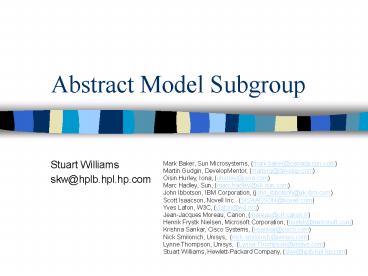Abstract Model Subgroup - PowerPoint PPT Presentation
1 / 16
Title:
Abstract Model Subgroup
Description:
The core abstraction is then around XMLP message exchange (through processing intermediaries) ... Service Abstraction describes protocol operations as event ... – PowerPoint PPT presentation
Number of Views:34
Avg rating:3.0/5.0
Title: Abstract Model Subgroup
1
Abstract Model Subgroup
Mark Baker, Sun Microsystems, (mark.baker_at_canada.
sun.com) Martin Gudgin, DevelopMentor,
(marting_at_develop.com) Oisin Hurley, Iona,
(ohurley_at_iona.com) Marc Hadley, Sun,
(marc.hadley_at_uk.sun.com) John Ibbotson, IBM
Corporation, (john_ibbotson_at_uk.ibm.com) Scott
Isaacson, Novell Inc. (SISAACSON_at_novell.com) Yves
Lafon, W3C, (ylafon_at_w3.org) Jean-Jacques Moreau,
Canon, (moreau_at_crf.canon.fr) Henrik Frystk
Nielsen, Microsoft Corporation,
(frystyk_at_microsoft.com) Krishna Sankar, Cisco
Systems, (ksankar_at_cisco.com) Nick Smilonich,
Unisys, (nick.smilonich_at_unisys.com) Lynne
Thompson, Unisys, (Lynne.Thompson_at_unisys.com) Stu
art Williams, Hewlett-Packard Company,
(skw_at_hplb.hpl.hp.com)
- Stuart Williams
- skw_at_hplb.hpl.hp.com
2
- Overview of Model
- Status
- Plans
- Issues
- Questions
3
Overview of Model
- Descriptive Tool
- Focus on WHAT, not HOW
- A means to develop clarity over the WHAT XMLP is
and what (functionally) it does. - A potential means to partition the design task.
- A potential means to structure a document
collection.
4
Model Outline
- Top Level Overview
- Service Abstraction
- One-way, Two-way request/response and
Intermediary operation. - Modules and Applications
- Path, Targetting
- Binding
- BindingContext and Arbitrary Attachments
- Security
- Mostly a placeholder defers to Bindings and
Modules
5
Top-Level Diagram
6
Service Abstraction
- Its hard to abstract the functionality of
arbitrary modules! - XMLP Handlers positioned above the XMLP Layer
into XMLP Applications - The core abstraction is then around XMLP message
exchange (through processing intermediaries). - Service Abstraction describes protocol operations
as event patterns seen from above. - Layer Entity (XMLP Processor) implements the
procedural rules of the protocol (which have yet
to be designed). - Layer Supports 3 operations for the exchange of
XMLP messages - XMLP_Data (Two-way req/resp.) (4 events)
- XMLP_UnitData (one-way) (3 events)
- XMLP_Intermediary (2 events)
Events between Layer Entity and Layer Clients
Upper Layer Boundary
Layer Entity
Events between Layer Entity and Underlyling
Protocol(s)
7
Operations Summary
8
Operation through Intermediaries
1
2
3
4
Time
Initiating XMLP Application
Intermediary XMLP Application
Responding XMLP Application
5
6
- Layer Primitives Key
- XMLP_Data.request
- XMLP_Intermediary.indication
- XMLP_Intermediary.resend
- XMLP_Data.indication
- XMLP_Data.response
- XMLP_Data.confirm
NB. Response could also be processed by an
Intermediary
9
Event Parameters
NextHop and Path Modelling
Message Components
Intrinsic support for Attachments
Catchall for underlying protocol capabilities,
properties etc. eg. UserID/password,
certificates/keys say HTTP, SSL, HTTPS.
10
Applications, Modules and Handlers
An XML Protocol Module encapsulates the
definition of one or more related XML Protocol
Blocks and their associated processing rules.
These processing rules are realised in one or
more XML Protocol Handlers. An XML protocol
application is responsible for identifying and
dispatching targeted XML protocol handlers
11
Message Path and Targeting
- This is a topic of active debate how/whether to
support message path as 1st class notion in XMLP - ImmediateDestination, OrigPath and ActualPath
make current draft neutral to the resolution of
this discussion. - Need for terminology around types of targeting
Directed, Functional, Group - Issues of handler processing order semantics.
12
Binding and Attachments
- Service Abstraction provides intrinsic support
for Arbitrary Attachments - Implications
- An intrinsic mechanism for carrying and
referencing arbitrary attachments carried
(somewhere) within the outermost XML construct
(for bindings to protocols that dont have
intrinsic support for arbitrary attachments). - Binding specific mechanisms to carry attachments
in more efficient ways. - ebXML/SOAP with Attachments discussion.
- Topic of active discussion
- BindingContext mentioned earlier.
- Container for parameters/properties of underlying
protocols - Eg. UserID/Passwd, Key(Refs)/Certificates, QoS
- Means to deliver binding specific context
information to XMLP Application and Handlers.
13
Security
- Refers to BindingContext to exploit any
underlying security features. - Refers to XMLP Modules (extensions) for
Application layer security.
14
AMG Document Status
- Work of a subgroup of the XMLP-WG
- 4 Phone Conferences One major rewrite.
- Good handle on basic message exchanges and model
of XMLP processing intermediaries. - Section 3. (Service Abstraction) is problematic
for some. - Treatment of Fault Handling, Paths, Targeting and
Attachments is still open (require work).
15
AMG Plans
- Solicit Feedback from WG
- Need to know whether WG regarded this as a useful
contribution. - Participate in and synthesis from Path/Targeting
and Arbitrary Attachment discussions - Seed further discussion of Fault handling.
- Road-test Model against DSs, Ss, SOAP 1.1 and
SOAP with Attachments.
16
AMG Issues
- Requirements Glossary and AM Definition of Terms
These are closely related and in most cases
aligned. Need to converge to a single reference. - Section 3. Stuart regards it as a crucial part of
abstraction of XMLP - the WHAT of XMLP. Henrik
regards it as being too close to an API
definition (larger note in Issues section). - Intrinsic support for BOTH two-way
request/response and one-way operations do we
need both? - Questions

